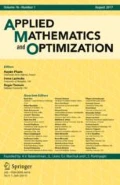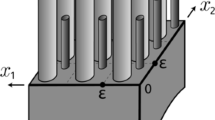Abstract
This paper deals with the homogenization of a sequence of non-linear conductivity energies in a bounded open set \(\Omega \mbox{ of } {\Bbb R}^d, \mbox{ for } d\geq 3.\) The energy density is of the same order as \(a_\varepsilon({x/\varepsilon})\,|Du(x)|^p,\) where \(\varepsilon\to 0, a_\varepsilon\) is periodic, u is a vector-valued function in \(W^{1,p}(\Omega;{\Bbb R}^m)\) and \(p>1.\) The conductivity \(a_\varepsilon\) is equal to 1 in the "hard" phases composed by \(N\geq 2\) two by two disjoint-closure periodic sets while \(a_\varepsilon\) tends uniformly to 0 in the "soft" phases composed by periodic thin layers which separate the hard phases. We prove that the limit energy, according to γ-convergence, is a multi-phase functional equal to the sum of the homogenized energies (of order 1) induced by the hard phases plus an interaction energy (of order 0) due to the soft phases. The number of limit phases is less than or equal to N and is obtained by evaluating the γ-limit of the rescaled energy of density \(\varepsilon^{-p}\,a_\varepsilon(y)\,|Dv(y)|^p\) in the torus. Therefore, the homogenization result is achieved by a double γ-convergence procedure since the cell problem depends on ε.
Similar content being viewed by others
Author information
Authors and Affiliations
Corresponding authors
Rights and permissions
About this article
Cite this article
Braides, A., Briane, M. Homogenization of Non-Linear Variational Problems with Thin Low-Conducting Layers. Appl Math Optim 55, 1–29 (2007). https://doi.org/10.1007/s00245-006-0861-6
Accepted:
Published:
Issue Date:
DOI: https://doi.org/10.1007/s00245-006-0861-6




